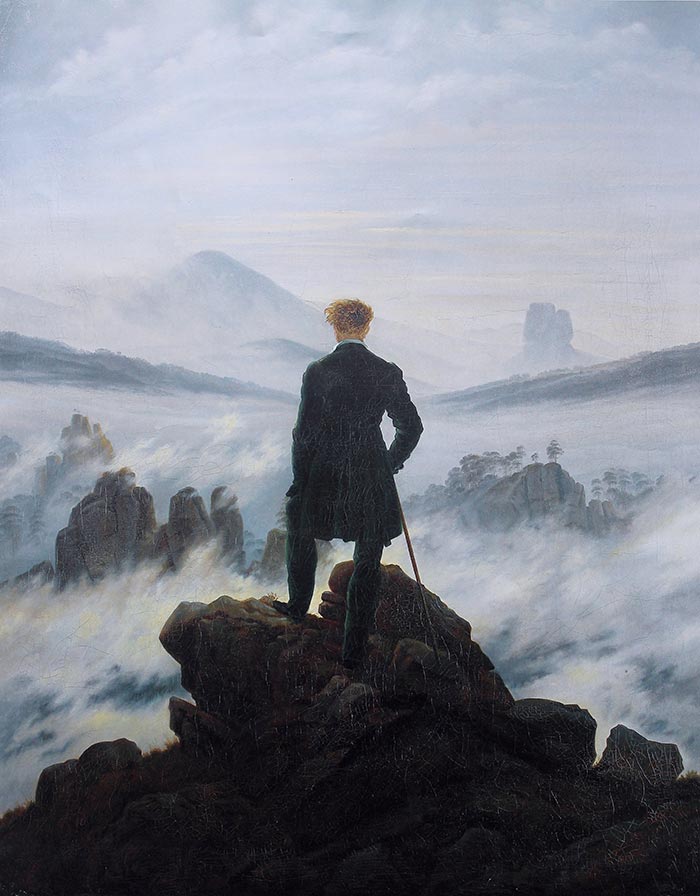Wanderer above the Sea of Fog is an oil painting by a German artist, Caspar David Friedrich, created in 1818. It depicts a young man standing back to the viewer at the precipice, observing mountain ranges that extend in front of him (Friedrich, 1818). He is wearing a long overcoat and holds a walking stick. The landscape has a vertical orientation, probably to emphasize the presence of a man.
This painting is considered a masterpiece of Romanticism – an artistic movement that spread in Europe at the end of the 18th – the beginning of the 19th century. It aimed to challenge the Enlightenment era’s dominating ideas (such as reason and order) by emphasizing the emotional component of human life (Romanticism, n.d.). The artists tried to fully express the possibilities of individual senses, intuition, and imagination in appreciating and exploring the world. Nature – wild and untamed – also became the central topic of many artworks (Cohen, 2018). Thus, Friedrich’s painting with a lonely man facing the beautiful yet overwhelming mountain landscape can be viewed as an illustrative work of the movement.
However, his paintings also have certain distinctive features that make them particularly recognizable. One of these characteristics is the subtle color palette he employs when depicting nature (Caspar David Friedrich, n.d.). Though unlike many of his landscapes, due to human presence, Wanderer does not create an unusual sense of emptiness; the mountain ranges are covered with similar distinctive fog often seen in Friedrich’s paintings.
To understand the artwork better, it might be useful to explore in more depth the influences that shaped the master’s style, in general, and contributed to the creation of the Wanderer, in particular. Friedrich received a formal artistic education at the University of Greifswald and at the Academy of Copenhagen, where he studied under Jens Juel, a well-known Danish portraitist (Cohen, 2018). However, it can be noted that unlike many painters, he took less inspiration in the works of masters before him, but was more invested in defining and sharpening his unique style that, in turn, influenced Romanticism. His personality traits, such as melancholic tendencies, seem to have significantly impacted his works (Cohen, 2018). To find inspiration for his landscapes, he tended to travel a lot (Cohen, 2018). The one in Wanderer does not reflect a real place but comprises different parts of the Elbe Sandstone Mountains (Scott, 2020). The result of multiple sketches he made there is the glorious view seen in the painting.
There are different opinions on the male figure’s identity. Some researchers claim that it can be a self-portrait, while others suggest that it might be an individual known to Friedrich, Colonel Friedrich Gotthard von Brincken, who was killed in action (Scott, 2018). Though the latter idea might give the painting a patriotic outlook, there is no enough evidence to suggest that any of the existing theories are necessarily accurate. What is also interesting is that some suggest that Friedrich applied the standards of the Golden Ratio developed by Luca Pacioli while working on the painting (Jones, 2020). That helped to ensure that the man is standing right in the middle of the whole scene that, in turn, attracts the viewer’s attention to the figure, prompting to concentrate on his experiences.
To better understand a painting, it is essential to research the master’s sources of inspiration and the history of its creation. In the case of the Wanderer, it was incredibly helpful for me to acknowledge the main motives and ideas of the Romantic movement to appreciate the importance of individual experience in front of the vast mountain ranges depicted in the picture. I was able to feel how this lonely figure may symbolize both unity with nature and feeling overwhelmed by it. Moreover, a detailed look into the painter’s characteristics, influences, and inspiration helped analyze the main attributes of this artwork. For instance, different ideas about the man’s identity provided me with an opportunity to consider it from several perspectives.
References
Friedrich, C. D. (1818). Wanderer above the Sea of Fog [painting]. Kunsthalle Hamburg, Hamburg, Germany.
Caspar David Friedrich (n.d.). The Art History. Web.
Cohen, A. (2018). Unraveling the mysteries behind Caspar David Friedrich’s “Wanderer”. Artsy. Web.
Scott, D. (2020). A closer look at Wanderer Above the Sea of Fog by Caspar David Friedrich. Draw Paint Academy. Web.
Jones, C. P. (2020). How to read paintings: Wanderer above the Sea of Fog by Caspar David Friedrich. Medium. Web.
Romanticism (n.d.). The Art History. Web.
Appendix
